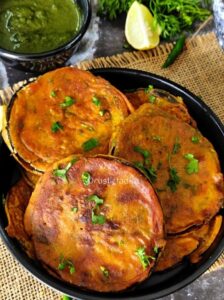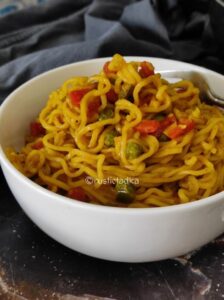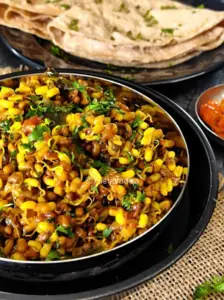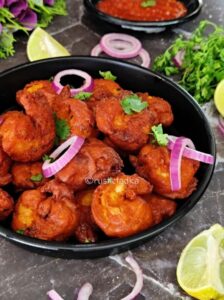Maharashtrian Alu Vadi, also known as Patra or Patrode in some regions, is a traditional and popular savoury snack or appetizer from the Indian state of Maharashtra.
It is made primarily with colocasia leaves (also called taro leaves or arbi ke patte) rolled with a spiced gram flour (besan) paste, steamed or fried until cooked.
This is a vegan, gluten-free, protein-rich, no onion no garlic, snack recipe.
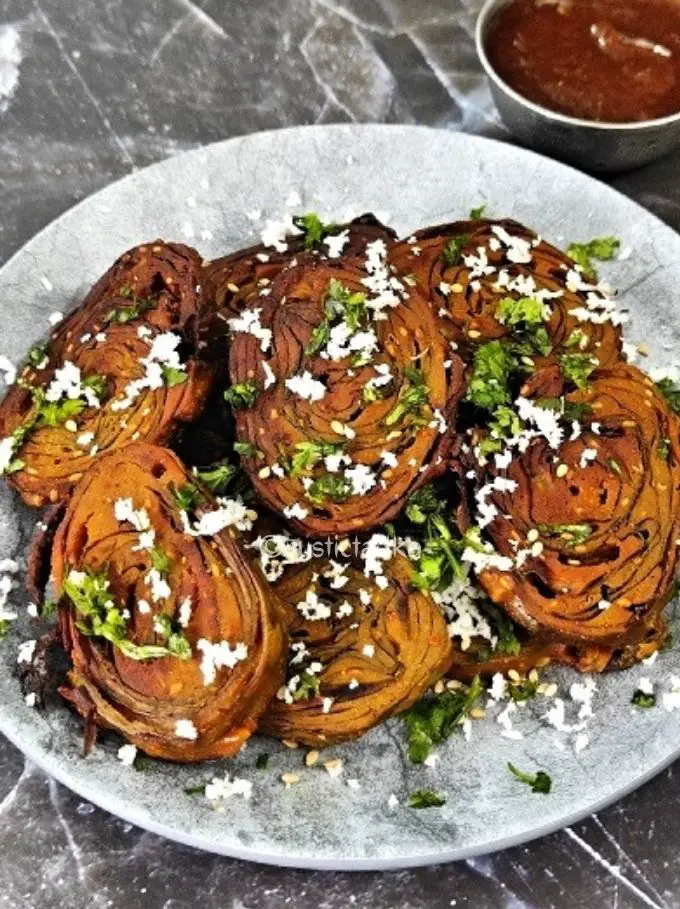
[convertkit form=7110706]
About alu Vadi
Alu vadi is known for its distinctive taste, which is a blend of tangy, sweet, and spicy flavours.
The main ingredients required for making Alu Vadi include Alu Chi Paane (colocasia leaves), gram flour (besan), tamarind pulp & jaggery for the sweet and tangy taste.
Spices such as red chili powder, cumin, coriander powder and roasted sesame seeds are added to infuse the flavours.
The gram flour paste is prepared by mixing besan with water and adding spices. Some variations may include garlic and ginger for added flavour. The mixture is then whipped to form a smooth and thick paste.
The colocasia leaves are washed thoroughly and dried. They are then trimmed, and the central vein on the backside of the leaf is removed to make them smoother for rolling.
Each colocasia leaf is coated with a layer of the prepared gram flour paste on one side. The leaves are then stacked on top of each other, and the process is repeated until all the leaves are coated and stacked, forming a single roll.
The rolled alu leaf (colocasia leaf) stack is steamed first which takes about 25 minutes. Once cooked & cooled, it is sliced into roundels. At this point of time, one can add a tadka of mustard seeds, sesame seeds, and hing and pour over the alu vadi OR you can shallow-fry or deep fry.
This alu vadi is served as a delicious snack along with meals as a side dish or during tea time. It pairs best with green chutney or tamarind chutney.
Steaming is the healthier option, but frying adds a crispier texture.
The Maharashtrian Alu Vadi is not only loved for its taste but also for its nutritional value, as colocasia leaves are rich in dietary fiber, vitamins, and minerals.
It’s a delightful dish that reflects the culinary heritage of Maharashtra and is often prepared during festivals, gatherings, or simply as a special treat for the family.
Recipe Video
ingredients
Alu Leaves (Colocasia Leaves) – In Marathi we call it, alu chi paane. We need to wash the leaves thoroughly with water and discard the stems.
Besan (Gram Flour) – We will require besan to make the tangy & sweet paste that we will apply to all the colocasia leaves.
Tamarind & Jaggery – To give that unique taste to alu vadi we will use tamarind which we need to soak in water for about 30-60 minutes and squeeze out the pulp.
We will need to add jaggery and mix it with the tamarind pulp to get that sweet & tangy flavour.
Spices & Seasoning – Basic spices like turmeric powder, red chilli powder, coriander & cumin seed powder are added. Salt to taste.
Oil – For frying.
Frequently Asked Questions
Can I use any type of (arbi leaves) colocasia leaves to make alu vadi?
No, there are two types of colocasia leaves, one is used for cooking curry and the other for making alu vadi. Ask the vendor to give leaves that are ment for making vadi only. Also, look for tender, young leaves with fewer veins to avoid bitter taste and itchiness.
How to avoid itchiness from arbi leaves (colocasia leaves)?
Make sure to use tender leaves and remove the thick veins. Also adding a bit of tamarind paste to the batter helps to reduce the itchiness.
Can I bake Alu Vadi instead of frying?
Yes, bake the steamed alu vadi at 350°F (175°C) for 15-20 minutes, turning halfway through. Cook until crisp. This is a perfect healthier alternative to frying alu vadis.
Can I use other leaves if arbi leaves (colocasia leaves) aren’t available?
Yes, you can experiment with different green leafy veggies like spinach. However, the taste will differ.
Serving Suggestions
With Chutney – Alu vadi pairs best with green coriander chutney & tangy tamarind chutney.
You can serve alu vadi as a side dish with the main meal.
Alu vadi also makes a perfect tea-time snack with a cup of hot adrak chai (tea) or coffee.
Storage Options
Alu vadi stays good for about 4-5 days in the refrigerator. Store it in an air-tight container. Thaw & reheat before serving.
Related Recipes
Alu Chi Patal Bhaji (Alucha Fadfada)
No Onion No Garlic (Satvik) Recipes
More Traditional Maharashtrian Recipes
Dudhi Halwa (Lauki Halwa), Dadpe Pohe (No Cook Poha Recipe), Sanja (Spicy Upma), Policha Ladoo (Roti Ke Laddu), Sabudana Vada, Tondali Masale Bhaat, Valachi Khichadi (Dalimbi Bhaat), Maharashtrian Kadhi
How to make Maharashtrian Alu Vadi
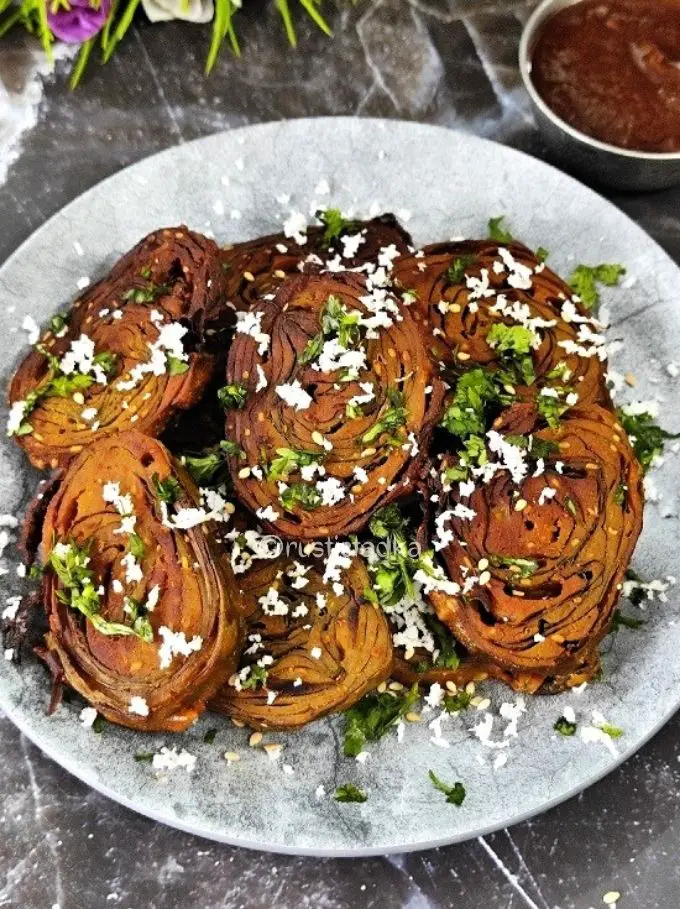
Note:
You can also add ginger-garlic paste to the besan batter to enhance the taste of this dish.
To make the alu vadi crispy, you may opt to add a tablespoon of rice flour (chawal ka atta).
Join “Easy Indian Vegetarian & Vegan Recipes” on Facebook & be a part of our community.
If you like recipes like these, let’s connect on YouTube, Instagram & Facebook.
Thank you for stopping by, I would really love to know your thoughts on this recipe.
Also, do check out my Lifestyle Blog eralivine.com if interested.
Recipe Card

Alu Vadi Recipe | Patra Recipe
Ingredients
Method
- Clean the colocasia leaves and remove the stems. Pat them dry with a clean cloth or paper towel.
- Soak 1/4th cup tamarind for 30 – 60 minutes in water.
- Once soaked, squeeze the pulp out from the tamarind. Tamarind pulp is ready.
- Add jaggery and mix the jaggery so that it incorporates well with the tamarind pulp. You can grate and add jaggery to the this tamarind paste.
- In a mixing bowl, add besan (gram flour).
- Add spices, turmeric powder, coriander powder, cumin powder, red chilli powder and salt to taste.
- Add roasted sesame seeds. Mix this mixture.
- Now add the tamarind and jaggery water and make a thick paste.
- Our sweet & tangy paste for alu vadi is ready. Check seasoing and adjust accordingly. Make sure the batter is very thick and should not be in runny consistency.
- Place the larger leaf first on a clean surface.
- Spread the batter on the leaf.
- Now place the second leaf pointing in the opposite direction as shown in the picture below. Apply the paste and arrange the remaining leaves the same way.
- Once we have finished applying the paste. First, roll the vertical edges and apply some batter again.
- Apply the besan paste all over the leaves as shown below.
- Now roll the leaves horizontally. Apply little paste everytime you roll, this helps in binding the leaves well.
- Apply some paste on both the edges too. Make the reaming alu vadi the same way.
- Our Alu Vadi Unde (rolls) are ready.
- Place the rolls into a steamer. Before placing the rolls, make sure to grease the steamer with little oil.
- Steam for about 20 – 25 minutes.
- Our steamed rolls are ready.
- Let them cool a bit and then cut them into slices.
- Alu vadi is ready, here you can eat them without frying and serve them with a combination of tamarind chutney & spicy green chutney. Or you can fry them in oil or temper.
- To shallow fry the alu vadis, add 2 tbsp oil in a non-stick pan and place the sliced alu vadi and fry from both sides till golden brown and crisp.
- Fry the alu vadis on medium to high flame.
- Crispy, sweet, tangy & spicy Alu Vadi is ready to serve.
- Lastly, garnish with roasted sesame seeds, freshly scrapped coconut & coriander leaves.

